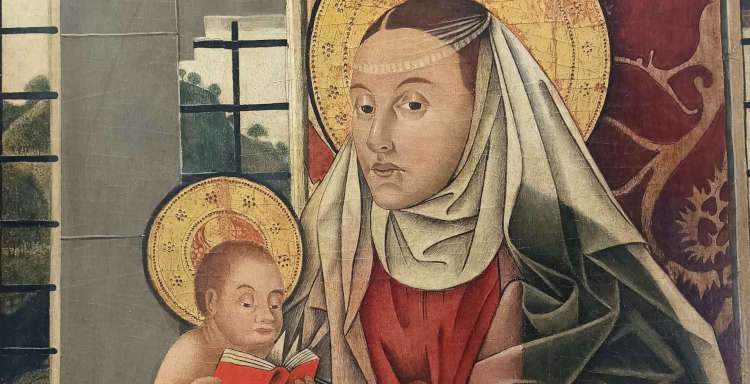One of Calabria’s 15th-century masterpieces to enhance the State Museum of Mileto (Vibo Valentia). From Nov. 8, 2023, to Jan. 31, 2024, in fact, the Calabrian museum will welcome the Madonna of Pears by Paolo di Ciacio da Mileto, on loan from the Civic Museum of Altomonte (Cosenza), for an exhibition that is part of a cultural project shared by the Calabria Regional Directorate of Museums of the Ministry of Culture (on which the Mileto museum depends) with the Department of Humanistic Studies of the University of Calabria and with the Municipality of Altomonte, coordinated by the director of the site, Maurizio Cannatà, and which is linked to the participation of the State Museum of Mileto in the exhibition Calabria Angioina, which opened Monday at the Civic Museum of Altomonte, through the display of valuable marbles from the Angevin period from the Sanseverino and Fazzari monuments of the ancient cathedral of Mileto.
The project thus makes it possible to exhibit in the State Museum of Mileto the famous painting of the Madonna of Pears, one of the most important and rare testimonies of Calabrian painting of the 15th century, a precious example of the region’s artistic culture updated to Flemish painting and northern Italian pictorial innovations, which landed in the South through the work of Antonello da Messina.

The panel, intended to decorate the main altar of the church of Santa Maria della Consolazione in Altomonte, was painted on red pine wood from Sila by Paolo di Ciacio, a painter who was a native of ancient Mileto itself and a pupil, as documents of the time report, of the illustrious Sicilian master Antonello da Messina. The painting depicts the Virgin intent on feeding her Son with a pear, carefully selected from those held in her right hand (hence the title Madonna of the Pears), a symbol of the sweetness of the love she nurtured for him and an allusion to the Eucharistic sacrifice.
The display of the panel, curated by Mileto Museum director Maurizio Cannatà and art historians Antonio Geremicca and Stefania Paone of the University of Calabria, was made possible thanks to the contribution of the Municipality of Mileto and Mayor Salvatore Fortunato Giordano.
It is precisely the Regional Directorate of Museums of Calabria led by Filippo Demma that has put in place an important program for the enhancement of the Mileto museum, which will soon allow the start of new works of rearrangement and adaptation of the exhibition itinerary as well as a series of cultural agreements with administrations and research institutes in the wake of the one with the Municipality and the Civic Museum of Altomonte. “We supported the initiative,” said the acting head of the Calabria Regional Directorate of Museums Filippo Demma, “because we are convinced of its success and, above all, of this exchange project. I thank all those who made this significant exhibition possible with their active contribution. Collaboration and synergy has been mentioned several times. We, as the Regional Directorate of Museums, are there to continue working on a whole series of integrated enhancement agreements that will allow us to collaborate with municipalities, dioceses, associations and companies by involving both the public and private sectors in this great enterprise of creating local cultural-based development systems that become tourist and investment attractors.”
The State Museum of Mileto, housed inside the 19th-century bishop’s palace adjacent to the neo-Romanesque Cathedral of Santa Maria Assunta, is one of the most beautiful realities, a garrison of culture, a center of aggregation and training where cultural heritage is educated, and the identity and historical memory of an entire territory is guarded and preserved. Inside is preserved a precious collection of ancient and medieval marbles among the most important in Calabria, and this is demonstrated by the fact that so many Italian and foreign institutions ask to borrow works from ancient Mileto, since it is here that Roger I D’Altavilla placed the center of the Norman county of Calabria, promoted the establishment of the first Latin diocese in southern Italy there and founded the Abbey of the Holy Trinity, one of the largest and most important monasteries of the Italian Middle Ages.
 |
| A masterpiece from the 15th century in Calabria to enhance the Mileto State Museum |
Warning: the translation into English of the original Italian article was created using automatic tools. We undertake to review all articles, but we do not guarantee the total absence of inaccuracies in the translation due to the program. You can find the original by clicking on the ITA button. If you find any mistake,please contact us.